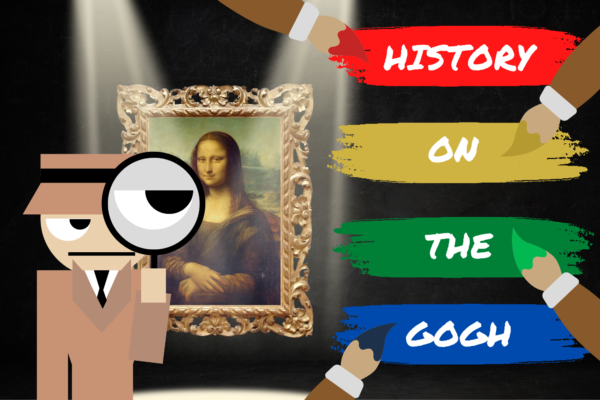
You walk into the Louvre and feel someone staring. You look around, but no one is there. But then you realize something. It’s not someone looking at you. It’s something—specifically, a painting. You look up and see a woman. A gentle smile, a refined pose, and – for some reason – eyes that seem to follow you wherever you walk.
No, this isn’t a haunted painting. It’s one of the most famous paintings in the world: the Mona Lisa! The painting was created by Leonardo da Vinci in 1503 and has become a masterpiece that defined the Italian Renaissance.
But how much do you know about the history of the Mona Lisa? From duplicates and forgeries to hidden images and even an art heist, this painting has seen quite a bit in the past 500 (or so) years. What secrets lie behind that famous smile? And why in the world do its eyes keep following me? Read on and find out!
Things you may not have known about Leonardo da Vinci and the Mona Lisa:
Sources:
- A Hidden Drawing Lies Beneath the ‘Mona Lisa,’ New Ultra-High-Resolution Images Reveal | Artnet News
- Did Leonardo Paint On Canvas.
- Provenance – The Mona Lisa Foundation
- Who were Francesco del Giocondo and his wife Lisa Gherardini? – The Mona Lisa Foundation
- Theft of “Mona Lisa” is discovered – HISTORY
- A timeline of attacks on the Mona Lisa | The Week
- Wait, the Mona Lisa isn’t a great example of the Mona Lisa Effect?

 d you know that the Mona Lisa actually has a hidden charcoal underdrawing beneath the paint? Using a special technology, scientists were able to detect faint charcoal drawings beneath the lighter paints of the Mona Lisa, showing that Leonardo used a special technique (spolvero technique) to outline the painting on the surface they are working on from an initial drawing.
d you know that the Mona Lisa actually has a hidden charcoal underdrawing beneath the paint? Using a special technology, scientists were able to detect faint charcoal drawings beneath the lighter paints of the Mona Lisa, showing that Leonardo used a special technique (spolvero technique) to outline the painting on the surface they are working on from an initial drawing.

 In 1911, the Mona Lisa was stolen by Vicenzo Peruggia, a former Louvre employee who wanted to steal the painting out of “patriotic duty” for Italy after it was taken by Napoleon and brought to France. The painting had been missing for two years until an art dealer in Italy was notified that the Mona Lisa was in Florence and would be returned for a large ransom. When Peruggia went to claim the ransom, he was captured, and the painting returned to the Louvre.
In 1911, the Mona Lisa was stolen by Vicenzo Peruggia, a former Louvre employee who wanted to steal the painting out of “patriotic duty” for Italy after it was taken by Napoleon and brought to France. The painting had been missing for two years until an art dealer in Italy was notified that the Mona Lisa was in Florence and would be returned for a large ransom. When Peruggia went to claim the ransom, he was captured, and the painting returned to the Louvre. Throughout history, vandals have attempted to damage or destroy the Mona Lisa. The different tools of destruction that were used included a razor blade, acid, a rock (which did chip off a tiny speck of paint, though the necessary repairs were made), red spray paint, a teacup, and – more recently – cake. Luckily, the painting has been well protected and preserved, with bulletproof glass covering it at all times to prevent further damage.
Throughout history, vandals have attempted to damage or destroy the Mona Lisa. The different tools of destruction that were used included a razor blade, acid, a rock (which did chip off a tiny speck of paint, though the necessary repairs were made), red spray paint, a teacup, and – more recently – cake. Luckily, the painting has been well protected and preserved, with bulletproof glass covering it at all times to prevent further damage. The Mona Lisa’s gaze is actually directed 15.4 degrees to the right, outside the perceivable range that a person feels like someone is directly watching them. The “Mona Lisa Effect” is an actual phenomenon, but the angle of the subject’s gaze cannot be more than 5 degrees to either side to begin “feeling their gaze.”
The Mona Lisa’s gaze is actually directed 15.4 degrees to the right, outside the perceivable range that a person feels like someone is directly watching them. The “Mona Lisa Effect” is an actual phenomenon, but the angle of the subject’s gaze cannot be more than 5 degrees to either side to begin “feeling their gaze.”



